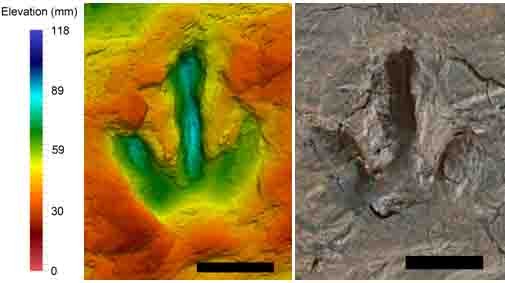New research reveals how two carnivorous dinosaurs walked along a beach together some 142 million years ago with their footprints left behind the sand as evidence.
These footprints evolved into fossilized specimens eventually and are now helping researchers gain a better understanding of what certain species of dinosaurs used to walk those beaches which is now modern day northern Germany.
The foot tracks are actually two sets where one is large and the other one smaller. The footprints also suggest that the dinosaurs walked at a slow, strolling pace some 3.9 miles per hour for the large one and 6 miles per hour for the smaller one.
According to Pernille Troelsen from the University of Southern Denmark, the smaller dinosaur is probably trying to keep a faster pace with the larger dinosaur where the footprints also indicate that the two are most likely slipping and skidding on wet sand.
Troelsen adds that the paces of the dinosaurs were slow which is a quite unique situation since carnivorous dinosaurs usually run at 25 miles per hour.These fossilized footprints are found in Germany's Bückeberg Formation where scientists have studied them for 200 years as Troelsen studied and examined two tracks made of 50 footprints that are preserved in layer made of silt and mudstone.
The larger dinosaur feet is roughly measured to be a U.S. men's size 15 shoe where the smaller dinosaur's footprint is comparable to a U.S. men's size 6 shoe. Additional analysis suggested that the larger one stands at 5.2 feet and the smaller one at 3.6 feet that were both classified under the carnivorous species Megalosauripusgenus, similar to the Velociraptor that ran on two legs and were ferocious hunters.
Researchers also revealed that the little dinosaur crossed its legs while walking on the beach probably because it lost balance since the sand was slippery or due to a sudden powerful gust of wind or it wanted to keep track with the larger dinosaur.
The story of these two is yet to be deciphered but Troelsen says that this clearly illustrates that they are social animals but it is still unclear if the footprints were made during the same timeline. However, most dinosaur footprints are found around Europe such as England, Germany and Spain from the Lower Cretaceous period dating back to 140 to 145 million years ago.



























